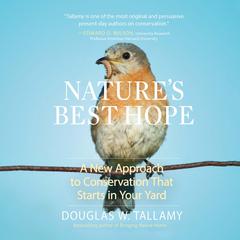 Play Audiobook Sample
Play Audiobook Sample
The Nature of Oaks: The Rich Ecology of Our Most Essential Native Trees Audiobook
 Play Audiobook Sample
Play Audiobook Sample
Quick Stats About this Audiobook
Total Audiobook Chapters:
Longest Chapter Length:
Shortest Chapter Length:
Average Chapter Length:
Audiobooks by this Author:
Publisher Description
“A timely and much needed call to plant, protect, and delight in these diverse, life-giving giants.” —David George Haskell, author of The Forest Unseen and The Songs of Trees
With Bringing Nature Home, Doug Tallamy changed the conversation about gardening in America. His second book, the New York Times bestseller Nature’s Best Hope, urged homeowners to take conservation into their own hands. Now, he is turning his advocacy to one of the most important species of the plant kingdom—the mighty oak tree.
Oaks sustain a complex and fascinating web of wildlife. The Nature of Oaks reveals what is going on in oak trees month by month, highlighting the seasonal cycles of life, death, and renewal. From woodpeckers who collect and store hundreds of acorns for sustenance to the beauty of jewel caterpillars, Tallamy illuminates and celebrates the wonders that occur right in our own backyards. He also shares practical advice about how to plant and care for an oak, along with information about the best oak species for your area. The Nature of Oaks will inspire you to treasure these trees and to act to nurture and protect them.
Download and start listening now!
"Packed with fascinating stories of ecological connections and wonders, this beautiful book is a hymn to the keystones of the forest, the oaks. A timely and much needed call to plant, protect, and delight in these diverse, life-giving giants."
— David George Haskell, author of Pulitzer finalist, The Forest Unseen, and Burroughs Medalist, The Songs of Trees; Professor, University of the South "Powerfully engaging from start to finish, The Nature of Oaks is joyful, scientific storytelling at its best.
The Nature of Oaks Listener Reviews
Be the first to write a review about this audiobook!
About Douglas W. Tallamy
Douglas W. Tallamy is the author of several books, including the New York Times bestseller Nature’s Best Hope. His book Bringing Nature Home won a silver medal from the Garden Writer’s Association. He is professor and chair of the department of entomology and wildlife ecology at the University of Delaware in Newark, Delaware, where he has taught insect taxonomy, behavioral ecology, and other subjects. Chief among his research goals is to better understand the many ways insects interact with plants and how such interactions determine the diversity of animal communities.
























